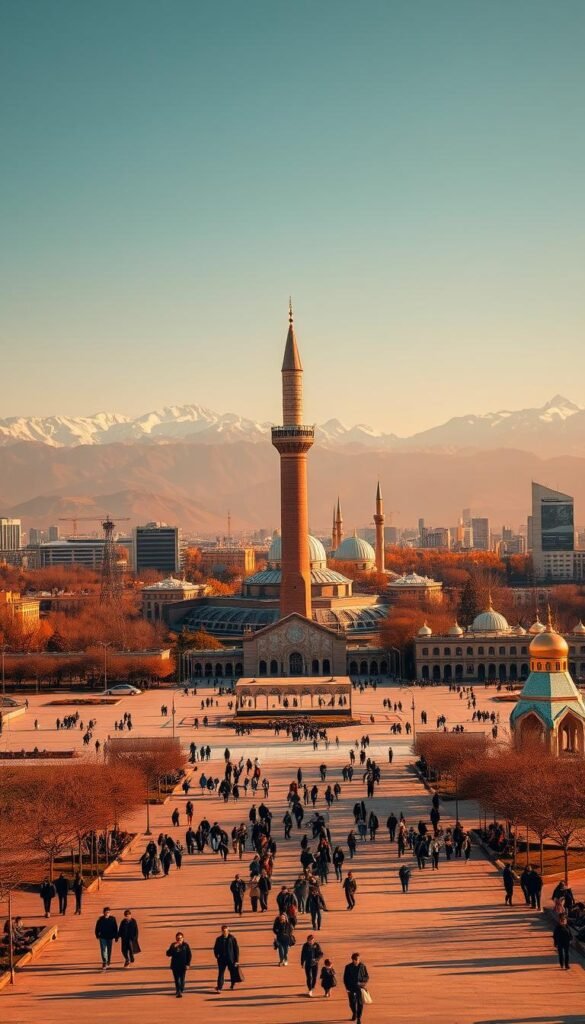
Imagine strolling through a city where ancient history meets modern vibrancy, where the aroma of exotic spices fills the air, and the taste of rich Persian cuisine delights your senses. Tehran, Iran’s capital city for over 200 years, is home to nearly 14 million people and offers a unique blend of traditional and modern attractions.
From ancient palaces and museums to vibrant bazaars and delicious local eateries, Tehran is a treasure trove of cultural experiences and culinary delights, making it a fascinating destination for every kind of traveler.
Key Takeaways
- Explore Tehran’s rich history through its ancient palaces and museums.
- Experience the city’s vibrant culture by visiting its bustling bazaars.
- Savor the flavors of traditional Persian cuisine at local eateries.
- Discover the best places to visit in Tehran for a well-rounded trip.
- Enjoy the unique blend of traditional and modern attractions Tehran has to offer.
Discovering the Heart of Iran: Tehran at a Glance
At the heart of Iran lies Tehran, a city that masterfully blends tradition with modernity. Tehran is a city that seamlessly weaves together its rich history, reflected in its stunning architectural landmarks, vibrant cultural scene, and bustling markets.
One of the top things to do in Tehran is visit the Golestan Palace, the former palatial residence of the royal Qajar dynasty. This historic complex is a testament to Iranian architecture and offers a glimpse into the country’s royal past.
Another must-visit attraction is the Grand Bazaar, an old historic bazaar with several entrances and corridors. It’s a labyrinthine marketplace where visitors can find everything from traditional handicrafts to local cuisine.
Tehran’s attractions cater to diverse interests, whether you’re a history buff, a foodie, or an adventure-seeker. The city’s cultural scene is vibrant, with numerous museums, galleries, and performance venues.
| Attraction | Description | Location |
|---|---|---|
| Golestan Palace | Former royal residence of the Qajar dynasty | Tehran’s historic center |
| Grand Bazaar | Historic marketplace with various goods | Tehran’s central bazaar area |
| National Museum of Iran | Museum showcasing Iran’s history and culture | Tehran’s cultural district |
As we explore Tehran’s top attractions, we discover the essence of Iranian culture and hospitality. From historical landmarks to cultural experiences, Tehran has something to captivate every visitor.
Tehran Sites to See and Top Food to Eat: Your Essential Guide
Tehran’s vibrant streets are filled with iconic sites and culinary delights waiting to be discovered. As you explore this bustling city, you’ll find that navigating its various attractions is made easier by its comprehensive transportation network.
Public Transportation Options
Tehran’s public transportation system is efficient, with an extensive metro network that covers much of the city. The metro is a convenient way to travel, offering a relatively affordable and quick means of getting around.
Taxi Services and Ride-Sharing Apps
For more direct or flexible travel, taxi services and ride-sharing apps are readily available. These options provide visitors with the convenience of door-to-door service, making it easier to explore Tehran’s many attractions.
Among Tehran’s iconic sites is the Tabiat Bridge, the largest pedestrian bridge in the city, connecting two public parks. It features cafes, spaces for outdoor activities, and a viewing platform, making it a must-visit.
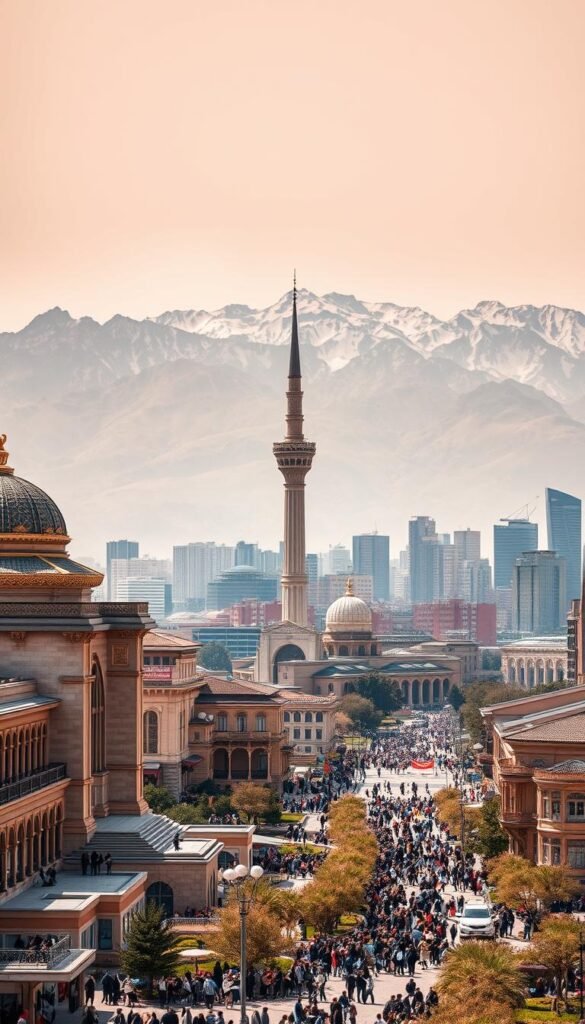
| Mode of Transport | Convenience | Cost |
|---|---|---|
| Metro | High | Low |
| Taxi/Ride-Sharing | Very High | Moderate |
With its blend of historical sites, modern attractions, and delicious cuisine, Tehran is a city that has something for everyone. Whether you’re exploring its cultural landmarks or enjoying its culinary delights, Tehran is sure to leave a lasting impression.
Iconic Landmarks in Tehran’s City Center
The iconic landmarks in Tehran’s city center are a testament to the city’s enduring legacy and cultural significance. Tehran, the capital city of Iran, is a metropolis that seamlessly blends traditional heritage with modernity. At its heart, the city center is home to some of the most revered and awe-inspiring landmarks that attract visitors from around the world.
One of the most striking landmarks is the Azadi Tower, an architectural marvel that was created to commemorate the 2,500th anniversary of the first Persian Empire. As a symbol of Iranian culture and history, the Azadi Tower is a must-visit attraction for anyone traveling to Tehran. Its unique blend of modern and ancient architectural styles makes it a fascinating sight, reflecting the rich cultural tapestry of Iran.
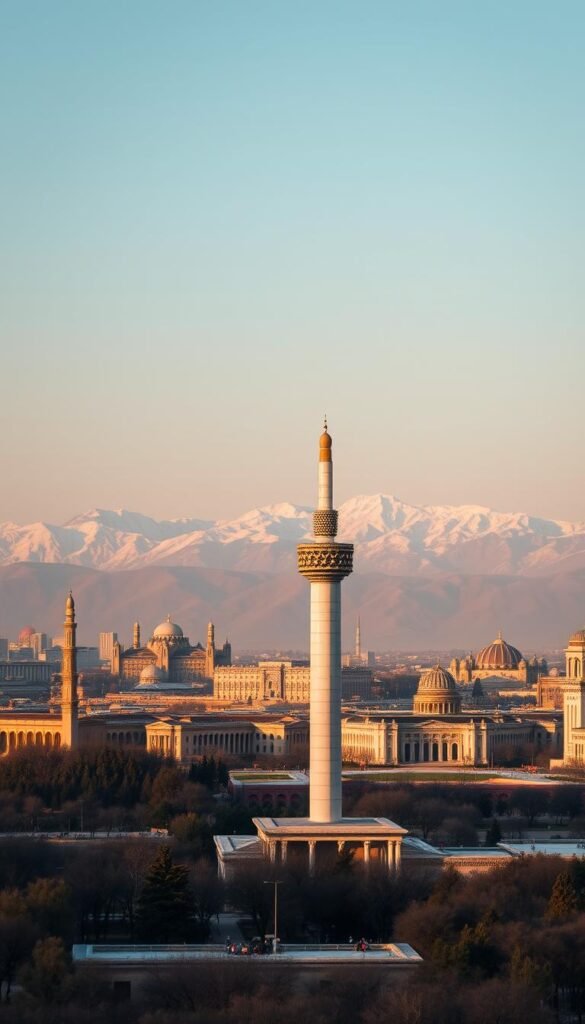
Another significant landmark in Tehran’s city center is the National Museum of Iran. Housing the largest collection of archaeological objects in the country, the museum provides a comprehensive insight into Iran’s history and cultural evolution. The museum’s collections span from ancient artifacts to pieces from the Islamic era, offering visitors a deep understanding of the region’s historical significance.
As
“Tehran is a city of contrasts, where ancient traditions meet modern aspirations.”
This contrast is evident in its city center, where historical landmarks like the Azadi Tower and the National Museum of Iran stand alongside modern architectural marvels. Visiting these iconic landmarks provides a unique glimpse into Tehran’s rich cultural heritage and its evolution over time.
Tehran’s city center is not just about historical monuments; it’s also a hub of cultural activity. The area is dotted with galleries, cultural centers, and traditional tea houses, each offering a unique perspective on Iranian culture. For travelers looking to experience the essence of Tehran, exploring these famous landmarks is an absolute must.
In conclusion, Tehran’s city center is a treasure trove of iconic landmarks that showcase the city’s rich history and cultural diversity. From the Azadi Tower to the National Museum of Iran, each landmark offers a unique window into the city’s past and present, making Tehran a fascinating destination for travelers and culture enthusiasts alike.
Northern Tehran: Mountains and Modern Attractions
As you venture into Northern Tehran, the landscape shifts, revealing a blend of luxurious palaces and breathtaking mountain vistas. This part of the city is a testament to Tehran’s ability to seamlessly merge tradition with modernity.
Northern Tehran is home to some of the city’s most famous landmarks, including the SaadAbad Complex. Located at the foothills of Mount Tochal, SaadAbad is a palatial ensemble that boasts luxurious palaces and beautifully manicured gardens. It’s a place where history and luxury converge, offering visitors a glimpse into the royal lifestyle of the past.
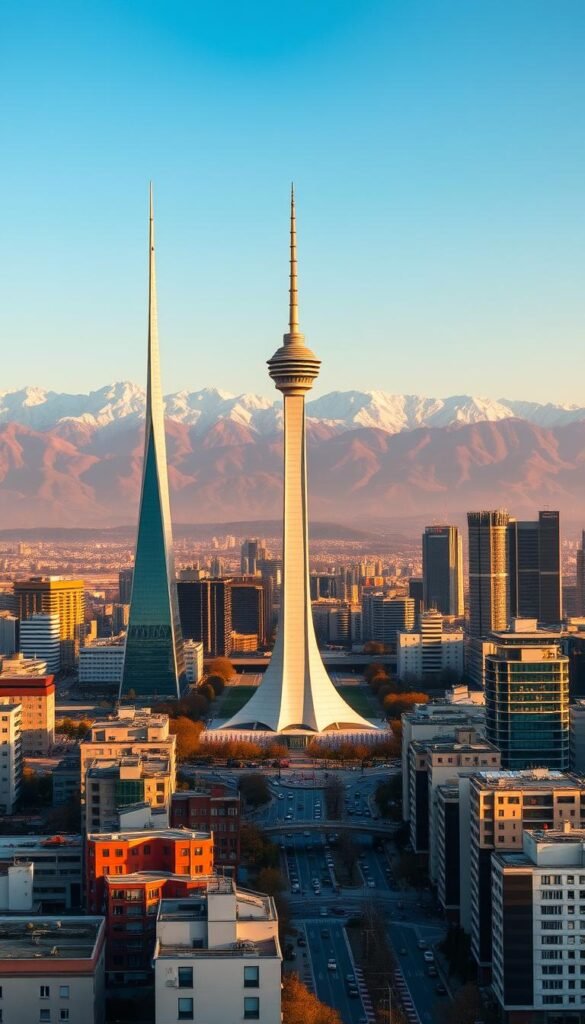
Another iconic site in Northern Tehran is Darband, a popular recreational area known for its traditional restaurants and teahouses. As one strolls through Darband, the aroma of local cuisine and the sound of flowing water create a serene atmosphere, making it a perfect escape from the city’s hustle and bustle.
“The mountains are calling, and I must go.”
Northern Tehran’s appeal lies in its diverse offerings, from historical sites like SaadAbad to natural attractions such as the mountains. Visitors can enjoy a range of activities, from exploring palaces to dining at traditional restaurants, making it a must-visit region for anyone traveling to Tehran.
The blend of modern attractions and natural beauty in Northern Tehran makes it a unique and captivating part of the city. Whether you’re interested in history, culture, or simply enjoying the outdoors, Northern Tehran has something to offer.
Tehran’s Museum Scene: Culture and History
Exploring Tehran’s museums is like stepping into a time capsule of Iran’s past. The city’s rich cultural heritage is preserved and showcased in its numerous museums, with the National Museum of Iran being a standout.
The National Museum of Iran is the main archaeological museum of Iran, housing collections that represent more than a million years of human settlement and cultural achievement in Iran. It is divided into two main sections: the Museum of Ancient Iran and the Museum of the Islamic Era.
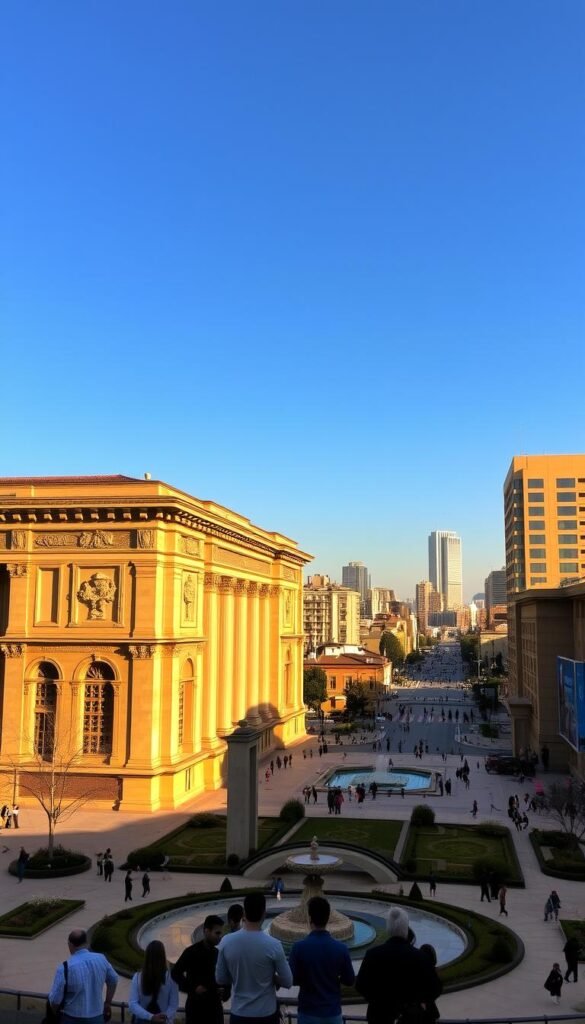
The Museum of Ancient Iran features artifacts from the prehistoric era, including the Paleolithic, Neolithic, and Bronze Ages. On the other hand, the Museum of the Islamic Era houses a vast collection of artifacts from the Islamic period, including coins, ceramics, and calligraphy.
Notable Exhibits in Tehran’s Museums
Some of the notable exhibits in Tehran’s museums include ancient pottery, historical coins, and intricate calligraphy. The museums also feature a range of artifacts that highlight the cultural and historical significance of the region.
| Museum | Notable Exhibits | Era |
|---|---|---|
| National Museum of Iran | Ancient pottery, historical coins | Prehistoric to Islamic Era |
| Museum of Contemporary Art | Modern Iranian art | 20th and 21st centuries |
| Reza Abbasi Museum | Islamic art and calligraphy | Islamic Era |
Tehran’s museums offer a glimpse into the city’s rich cultural and historical heritage. Visitors can explore a wide range of artifacts and exhibits that showcase the history and cultural achievements of Iran.
Parks and Green Spaces in Tehran
Among Tehran’s iconic sites, its parks and green spaces stand out as tranquil oases, providing a welcome respite from the city’s bustling atmosphere. One of the most notable examples is Tabiat Bridge, a modern landmark that connects two public parks, Taleghani Park and Abo-Atash Park. This pedestrian bridge not only offers majestic views of the Alborz Mountains but also serves as a vibrant recreational space for locals and tourists alike.
![]()
Tehran’s green spaces are a testament to the city’s efforts to balance urban development with natural beauty. These areas are not just visually pleasing but also provide a range of activities and services, from leisurely strolls to cultural events. The city’s parks are meticulously maintained, ensuring they remain inviting and accessible to everyone.
In addition to Tabiat Bridge, Tehran boasts numerous other parks and green spaces, each with its unique character. These areas are integral to the city’s landscape, offering a glimpse into Tehran’s commitment to preserving natural beauty amidst urbanization. Visitors can explore these spaces to experience the full spectrum of Tehran’s culture and natural scenery.
As part of Tehran’s famous landmarks, these parks and green spaces contribute significantly to the city’s appeal, making it a more enjoyable and livable place. Whether you’re interested in nature, architecture, or simply seeking a peaceful retreat, Tehran’s parks are a must-visit, showcasing the city’s diverse charm and its status as a hub of iconic sites in Tehran.
Delicious Persian Cuisine in Tehran
Tehran’s culinary scene is a reflection of Iran’s rich gastronomic heritage, offering a diverse range of delicious Persian cuisine. From traditional kebabs and rice dishes to hearty stews and soups, the city is a food lover’s paradise.
Iranian cuisine is known for its rich flavors and variety, and Tehran is the perfect place to experience it. The city’s restaurants and eateries serve a wide range of traditional Persian dishes that are sure to delight.
Kebabs and Rice Dishes
No visit to Tehran would be complete without trying some of the city’s famous kebabs. From juicy lamb kebabs to flavorful chicken kebabs, there’s a type to suit every taste.
- Kabab Koobideh (minced lamb kebabs)
- Kabab Barg (lamb kebabs)
- Jujeh Kabab (chicken kebabs)
These kebabs are often served with steamed rice, a staple in Persian cuisine.
Stews and Soups
Tehran’s culinary scene also features a variety of stews and soups that are both nourishing and flavorful.
- Ghormeh Sabzi (herb stew)
- Fesenjan (chicken stew in pomegranate sauce)
- Ash-e Reshteh (noodle soup)
Dizi and Sangak Bread
For a more authentic experience, try Dizi, a traditional Persian lamb stew served in a clay pot, and Sangak bread, a flatbread cooked on hot stones.
- Dizi: A hearty lamb stew with vegetables and beans
- Sangak Bread: Often served with kebabs or stews
Persian Sweets and Desserts
No meal is complete without dessert. Tehran offers a range of sweet treats, from baklava to saffron ice cream.
- Baklava: Layered pastry with nuts and honey
- Saffron Ice Cream: Creamy ice cream infused with saffron
Tehran’s culinary delights are a testament to the rich cultural heritage of Iran. Whether you’re trying traditional kebabs, stews, or sweet desserts, the city’s food scene is sure to leave a lasting impression.
Recommended Restaurants in Tehran
For a truly immersive experience in Tehran, exploring its recommended restaurants is a must. Tehran’s dining scene is a vibrant reflection of its cultural heritage, offering a diverse range of traditional Persian cuisine and international flavors.
Moslem Restaurant in Grand Bazaar
Moslem Restaurant, located in the historic Grand Bazaar, is renowned for its traditional Persian dishes. Visitors can enjoy authentic local flavors in a setting that echoes the city’s rich history.
The restaurant is particularly famous for its kebabs and stews, which are prepared using traditional recipes passed down through generations.
Dizi Sara and Nayeb Restaurants
Dizi Sara and Nayeb are two other highly recommended restaurants in Tehran. Dizi Sara is known for its traditional Iranian dish, Dizi, a hearty lamb stew served in a clay pot.
Nayeb Restaurant offers a range of traditional Persian cuisine in a beautifully restored historic house, providing a unique dining experience.
Cafes in Northern Tehran
Northern Tehran is home to modern cafes that offer a blend of traditional and contemporary dining experiences. These cafes are perfect for those looking to relax in a trendy atmosphere while enjoying a cup of coffee or a light meal.
Many of these cafes also serve a variety of international dishes, catering to the diverse tastes of Tehran’s cosmopolitan population.
International Cuisine Options
Tehran’s culinary scene is not limited to traditional Persian cuisine; the city also offers a wide range of international dining options. From Italian to Chinese, there’s something for every palate.
These international restaurants are often located in the more modern areas of the city, such as northern Tehran, and provide a welcome change of pace for locals and visitors alike.
| Restaurant Name | Cuisine Type | Location |
|---|---|---|
| Moslem Restaurant | Traditional Persian | Grand Bazaar |
| Dizi Sara | Traditional Iranian | Northern Tehran |
| Nayeb Restaurant | Traditional Persian | Historic House, Central Tehran |
| Cafe Modern | International | Northern Tehran |
Tehran’s dining scene is a testament to the city’s rich cultural heritage and its openness to international influences. Whether you’re in the mood for traditional Persian dishes or international cuisine, Tehran has a wealth of dining options to explore.
Planning Your Tehran Adventure: Tips from Seasoned Travelers
As you prepare to explore Tehran, getting around the city is easier than you think. The Tehran Metro is a convenient option, being clean, affordable, and modern, with coverage of almost all major attractions. Taxis and ride-sharing apps are also readily available, providing flexibility for your travel plans.
When visiting Tehran, be sure to explore beyond the iconic landmarks and indulge in the city’s culinary delights. Tehran sites to see and top food to eat are plentiful, making it an exciting destination for any traveler. Exploring Tehran’s culinary scene is a must, with its rich Persian cuisine offering a variety of flavors and dishes to savor.
With its rich history, cultural landmarks, and delicious food, Tehran promises an unforgettable experience. By planning ahead and knowing your options for getting around, you can make the most of your trip and enjoy all that Tehran has to offer.